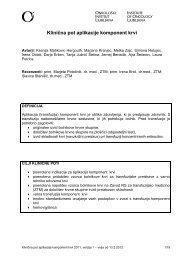Create successful ePaper yourself
Turn your PDF publications into a flip-book with our unique Google optimized e-Paper software.
Kallikrein-related peptidases: novel therapeutic target molecules<br />
Manfred Schmitt and Viktor Magdolen<br />
Clinical Research Unit, Dept. Obstetrics and Gynecology, Klinikum rechts der Isar, Technical University<br />
<strong>of</strong> Munich, Munich, Germany<br />
The novel tumor-associated biomarkers, the kallikrein-related peptidases (tissue kallikreins,<br />
KLK) KLK4-15 have the potential to serve as novel prognostic and even predictive markers<br />
for patients afflicted with solid malignant tumors. Tissue kallikreins are a subgroup <strong>of</strong> the<br />
serine protease enzyme family. Until the mid <strong>of</strong> the 1990s, it was thought that the human<br />
tissue kallikrein gene family contained only three members: (1) tissue kallikrein [KLK1],<br />
(2) glandular kallikrein-1 [KLK2], and (3) prostate-specific antigen [PSA/KLK3]. In<br />
the past years, the expansion <strong>of</strong> the human tissue kallikrein gene family from 3 to now<br />
15 members, all <strong>of</strong> which co-localize to chromosome 19q13.3-13.4 was reported. With<br />
the identification and characterization <strong>of</strong> all members <strong>of</strong> the tissue kallikrein gene family,<br />
accumulating reports have indicated that in addition to the established tissue kallikreins<br />
KLK1, KLK2, and KLK3, the novel tissue kallikreins KLK4 to KLK15 might also be<br />
related to hormonally regulated malignancies such as that <strong>of</strong> the prostate, testis, breast,<br />
and ovary.<br />
Growing evidence suggests that certain KLKs are involved in cancer progression; several<br />
may even serve as novel cancer biomarkers for tumor staging and prediction <strong>of</strong> therapy<br />
response, associated with the course <strong>of</strong> disease <strong>of</strong> cancer patients. While KLKs are<br />
expressed in a variety <strong>of</strong> normal tissues, such as prostate, ovary, breast, testis, the central<br />
nervous system, and skin, their expression or downregulation in tumor tissues have only<br />
partially been revealed by immunohistochemical approaches although expression <strong>of</strong> KLKs<br />
have been investigated in malignant tissue extracts by PCR (mRNA) or ELISA (protein).<br />
Therefore, we have generated/selected a panel <strong>of</strong> highly specific antibodies to various<br />
KLKs which allow localization and assessment <strong>of</strong> protein expression in tumor tissues.<br />
Recent advances in our laboratory allowed recombinant protein production <strong>of</strong> all <strong>of</strong> the<br />
15 KLKs in bacteria in their pro-forms and conversion into their enzymatically active<br />
l43<br />
forms. For some <strong>of</strong> the KLKs, protein crystals were obtained (KLK4, KLK5, KLK6,<br />
KLK7) and the structures <strong>of</strong> these kallikrein-related peptidases solved by crystallography.<br />
Furthermore, extended substrate specificity pr<strong>of</strong>iling for the nonprime side and further<br />
enzyme kinetic studies have been performed. The shape and polarity <strong>of</strong> the specificity<br />
pockets <strong>of</strong> the investigated KLKs explain very well the substrate preferences <strong>of</strong> KLK4, 5,<br />
6, and 7. KLK4 and KLK5 exhibit a trypsin-like specificity with a strong preference for<br />
P1-Arg, while KLK6 is less stringent for arginine in P1, but prefers this residue also in P2<br />
whereas KLK7 displays a unique chymotrypsin-like specificity for tyrosine both in P1 and<br />
P2 position. Comparison <strong>of</strong> structure and substrate specificity may support the discovery<br />
<strong>of</strong> natural substrates as well as the design <strong>of</strong> efficient inhibitory compounds for targeting<br />
these KLKs in vivo as a novel approach <strong>of</strong> tumor therapy.<br />
59
















